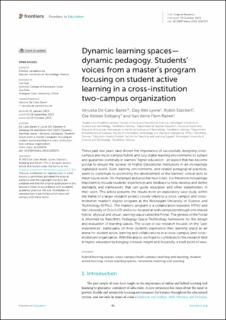| dc.contributor.author | de Caro-Barek, Veruska | |
| dc.contributor.author | Lysne, Dag Atle | |
| dc.contributor.author | Støckert, Robin | |
| dc.contributor.author | Solbjørg, Ole Kristen | |
| dc.contributor.author | Røren, Kari Anne Flem | |
| dc.date.accessioned | 2024-02-13T11:08:37Z | |
| dc.date.available | 2024-02-13T11:08:37Z | |
| dc.date.created | 2023-11-08T22:30:26Z | |
| dc.date.issued | 2023 | |
| dc.identifier.issn | 2504-284X | |
| dc.identifier.uri | https://hdl.handle.net/11250/3117233 | |
| dc.description.abstract | These past few years have shown the importance of successfully designing cross-campus and multi-campus hybrid and fully digital learning environments to sustain and guarantee continuity in learners’ higher education - an aspect that has become pivotal to ensure the survival of Higher Educational Institutions in an increasingly digitalized world. Such learning environments, and related pedagogical practices, seem to contribute to promoting the development of the learners’ critical skills to meet future work-life challenges and possible new crises. It is therefore increasingly important to include students’ experiences and feedback to help develop and define standards and frameworks that can guide educators and other stakeholders in their work. This article presents the results from an exploratory case study within the frame of a larger research project closely linked to a cross-campus and cross-institution master’s degree program at the Norwegian University of Science and Technology (NTNU). The master’s program is a collaboration between NTNU and the University of Oslo (UiO) and is co-located at both campuses through one shared hybrid, physical and virtual, learning space called the Portal. The genesis of the Portal is informed by Radcliffe’s Pedagogy-Space-Technology framework for the design and evaluation of learning spaces. The scope of our research focuses on the “user experiences”, particularly on how students experience their learning space as an arena for student active learning and collaborations in a cross-campus (and cross-institution) organization. With this article, we hope to contribute to the research field in higher education by bringing in newer insight and, hopefully, a fresh point of view. | en_US |
| dc.language.iso | eng | en_US |
| dc.publisher | Frontiers Media S. A. | en_US |
| dc.rights | Navngivelse 4.0 Internasjonal | * |
| dc.rights.uri | http://creativecommons.org/licenses/by/4.0/deed.no | * |
| dc.title | Dynamic learning spaces—dynamic pedagogy. Students’ voices from a master’s program focusing on student active learning in a cross-institution two-campus organization | en_US |
| dc.title.alternative | Dynamic learning spaces—dynamic pedagogy. Students’ voices from a master’s program focusing on student active learning in a cross-institution two-campus organization | en_US |
| dc.type | Peer reviewed | en_US |
| dc.type | Journal article | en_US |
| dc.description.version | publishedVersion | en_US |
| dc.source.volume | 8 | en_US |
| dc.source.journal | Frontiers in Education | en_US |
| dc.identifier.doi | 10.3389/feduc.2023.1155374 | |
| dc.identifier.cristin | 2194288 | |
| cristin.ispublished | true | |
| cristin.fulltext | original | |
| cristin.qualitycode | 1 | |

